Fish Passage Assessments
Prospect 3 Fish Screen and Ladder Biological Evaluation
PacifiCorp 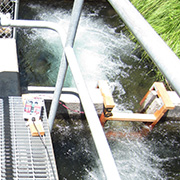
Meridian designed, fabricated, and installed a
remote PIT-tag detection system in the
Prospect No. 3 Hydroelectric Project fish
ladder. Four individual PIT-tag antennas were
continuously monitored using an Oregon RFID
half duplex multiplexer-reader. Meridian
PIT-tagged resident trout and introduced them
into the ladder to document upstream fish
passage success and timing. Meridian also
conducted a mark-recapture test to determine
fish entrainment and injury rate through the
project intake fish screens and fish bypass
system, and used PIT-tagged fish to measure
fish screen bypass travel time.
Clear Branch Dam Downstream Passage Survival Evaluation
Middle Fork Irrigation District 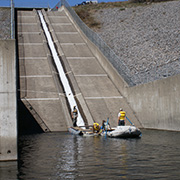
To support a NEPA evaluation and downstream
fish passage alternative development at Clear
Branch Dam in the upper Middle Fork Hood River
basin, Meridian developed, managed, and
coordinated a study to quantify juvenile
(hatchery spring Chinook salmon smolt) and
adult salmonid (hatchery rainbow trout) injury
and survival of fish that pass down the dam's
spillway. Test fish were sent down the
spillway at high and low flows. Treatment and
control test fish groups were recaptured with
a rotary screw trap and a fyke net trap. Field
data collection was also supported by U.S.
Forest Service, Oregon Department of Fish and
Wildlife, Confederated Tribes of Warm Springs,
and Middle Fork Irrigation Staff. Meridian
developed the study plan including sample size
estimates, and conducted all data analysis and
reporting. As part of the overall study,
Meridian collaborated with the Confederated
Tribe of Warm Springs to estimate fish
migration timing over the spillway and
associated spill rates using PIT tagged
hatchery spring Chinook and PIT tag
interrogation systems located at the spillway
crest and downstream.
Downstream Migrant Transport Flow Evaluation
Tacoma Power 
Using radio telemetry, Meridian biologists
assessed the migration rates and survival of
salmon and steelhead smolts as they moved
through the lower 50 miles of the mainstem
Cowlitz River. The effects of pulsed flows on
the migration timing of each species were
determined. We conducted all aspects of the
study, including design, setup and maintenance
of the telemetry arrays; radio tagging
hatchery and naturally produced coho, Chinook
and steelhead; mobile tracking; and data
analysis and reporting.
Lewis River Fish Passage System Operation
PacifiCorp 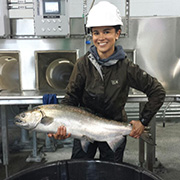
Since 2012, Meridian field biologists have
assisted PacifiCorp with seasonal operation of
the Lewis River Hydroelectric Project fish
passage facility from about October through
June each year. We help operate both the
Merwin trap to transport adult salmonids
upstream and the Swift Floating Surface
Collector to transport juvenile salmonids
downstream. Our biologists perform juvenile
and adult fish identification, handling,
sorting, juvenile salmonid PIT-tagging, data
entry, and facility cleaning and debris
management. Species handled typically include
bull trout, steelhead, cutthroat trout,
rainbow trout, and Chinook and coho salmon.
North Umpqua Hydroelectric Project Fish Passage Facility Evaluation
PacifiCorp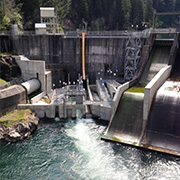
Meridian led a hydraulic and biological evaluation of newly installed fish passage facilities (upstream fish ladder and downstream fish screens) at the North Umpqua Hydroelectric Project. Meridian biologists used videography to describe fish behavior (with emphasis on adult steelhead and spring Chinook salmon), identify areas of the ladder that may inhibit passage, and evaluate fish injury and mortality rates associated with passage of downstream migrating juvenile spring Chinook salmon through the fish screen. Meridian also conducted an underwater videography evaluation of the Soda Springs and Slide Creek tailrace barriers to determine if they delay or injure to adult anadromous salmonids.
Estimation of Fish Entrainment at Lake Kachess and Keechelus Dams
US Bureau of Reclamation 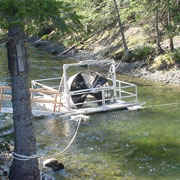
Meridian designed and conducted fish
entrainment studies at the outlets of Lake
Keechelus and Lake Kachess dams over a 2-year
period, focused primarily on evaluating bull
trout entrainment. Meridian employed a screw
trap and hydroacoustic technology to measure
continuous fish entrainment rates over the
4-month survey period at Lake Keechelus. At
Lake Kachess, we used a screw trap and
experimental fyke net trap to measure fish
entrainment rates. Meridian custom-designed
and built the experimental fyke net and screw
trap cable rigging system to ensure that these
structures would remain in place and perform
effectively throughout the survey period.

